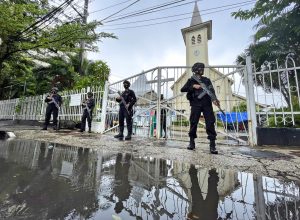Twenty people were injured in the suicide bombing of a church in Makassar, Indonesia on Palm Sunday, March 28, 2021. According to reports, the perpetrators were newly wedded millennials who learned how to make a bomb online and were affiliated with the Islamic State-linked Jamaah Ansharud Daulah (JAD). While suicide bombings have been a global trend for decades, the practice only penetrated Southeast Asia in the years after the 2002 Bali Bombings.
The recent spate of suicide bombing attacks makes it increasingly apparent that entire family units have been mobilized as suicide bombers. Some attribute this to the Islamic State’s appeal for the more active participation of women in terrorist attacks. Southeast Asia lags in the deployment of women as suicide bombers. Women have been perpetrators of suicide bombing campaigns elsewhere, including in Sri Lanka and Pakistan.
This article highlights trends of suicide bombing in Southeast Asia and factors that influence certain groups’ reasons for employing this tactic. A 2018 suicide attack in Surabaya initiated the trend of family suicide bombings in Southeast Asia. It also sparked media and academic curiosity because it highlighted the exploitation of women and children in terrorist attacks.
Suicide bombings have since been concentrated in the Philippines, mainly in the Sulu Archipelago. In 2019 alone, there were four suicide bombing attacks and attempts, primarily conducted by foreign families.
This was exemplified by the Jolo Cathedral Attack on January 27, 2019. The perpetrators of the attack were an Indonesian couple, Rullie Rian Zeke and Ulfah Handayani Saleh. The husband and wife attempted to travel to Syria to join the Islamic State but were deported from Turkey. The family then migrated to Sulu instead. A year after the attack, their daughter, Rezky Fantasya Rullie (alias “Cici”), was arrested for attempting to launch a suicide attack on October 10, 2020. Her husband is the deceased Andi Baso, a recruiter for Abu Sayyaf in Malaysia and Indonesia.
Two attempted attacks in Jolo, on September 8 and November 5, 2019, were also conducted by a single family unit. Reports claimed that the Egyptian perpetrators of the intercepted November 5 attack, Abduramli and Abdurahman, were the husband and son, respectively, of the September 8 attacker.
More recently, widows of deceased terrorists have been recruited to become suicide bombers in the Philippines. On August 26, 2020, the widows of two deceased terrorists, Nanah (widow of Norman Lasuca) and Indah Nay (widow of Talha Jumsah), launched a twin suicide attack at a military target near Paradise Food Plaza in Jolo. Subsequently, nine widows of slain terrorists were arrested for plotting suicide bombings in a counterterrorism raid on February 24 of this year.
However, suicide bombing operations in Southeast Asia have been primarily conducted by individuals, not hordes of radicalized families. Drawing data from the International Centre for Political Violence and Terrorism Research (ICPVTR) proprietary database, we identified 34 suicide bombing attacks and attempts in Southeast Asia since 2014. (Note that some attacks were coded separately as they were launched at different locations). Of these, 16 had no familial links, but seven were attempted/conducted by the widows of deceased terrorists, six by by husband-and-wife couples, and five by entire families.
Based on the ICPVTR database, some groups are more inclined to conduct suicide bombings than others. Members affiliated with the JAD are statistically more likely to execute suicide bombing missions than other Southeast Asia Islamist terrorist groups. This hyperlink displays the variations in the proportion of suicide bombing attacks and attempts of each group, with a 99 percent confidence interval.
Despite the utility of suicide bombings, there is good evidence that it is not widely accepted even within extremist Islamist communities in Southeast Asia, and each militant group differs in its receptiveness toward suicide bombing as a tactic. The legitimacy of the practice has also been contested within groups that seem to have accepted suicide bombing. In response to the 2018 Surabaya attack, Aman Abdurrahman, spiritual leader of the JAD, expressed his disagreement with the involvement of women and children in suicide bombing missions. While Aman deems the Indonesian state as kafir (infidel), he claimed that he has not appealed for attacks in Indonesia.
Despite his criticism, the JAD network has the highest proportion of suicide bombing attacks among terrorist groups in Southeast Asia. This might be due to the JAD’s decentralized structure and Abdurrahman’s incarceration. The absence of a clear hierarchy is what allowed local preachers like Khalid Abu Bakar Besleme to indoctrinate the perpetrators of the 2018 Surabaya attack with the “end-of-time” (yaumul qiyamah) prophecy. Others might justify suicide bombing as an istishhadi (martyrdom) operation.
Pro-martyrdom Islamist preachers could be vital in the indoctrination of suicide bombers. In 2016, Bahrun Naim influenced a series of suicide bombing attacks and attempts. Arguably, Hajan Sawadjaan, the deceased leader of the Abu Sayyaf’s Islamic State-aligned Sulu faction, was also an essential facilitator of suicide bombings in Jolo in 2019. Given the trends stated, individual personalities may potentially explain why some groups and cells are more willing to deploy suicide bombing than others.
Evidently, families of martyrs are at the forefront of suicide bombing operations in Southeast Asia today. The stream of families involved in suicide bombings in the region demonstrates the potency of violent extremist ideologies and their penetration into kinship networks.
Nonetheless, suicide bombing is still not widely accepted even within the region’s violent extremist networks. Even within the JAD, preachers have varying opinions about suicide bombing and the use of women and children as suicide bombers. But amidst the shifting sands of terror, preachers and ideologues remain central to the adoption of suicide tactics.
The spate of family martyrs shows that post-martyrdom preachers and ideologues can influence entire family units to do their bidding. Governments in this region must continue to identify and monitor such preachers to interdict potential suicide attacks. Local authorities can also empower moderate preachers within various municipalities to counter extremist narratives or clarify any ideological uncertainties that exist within the community.

































